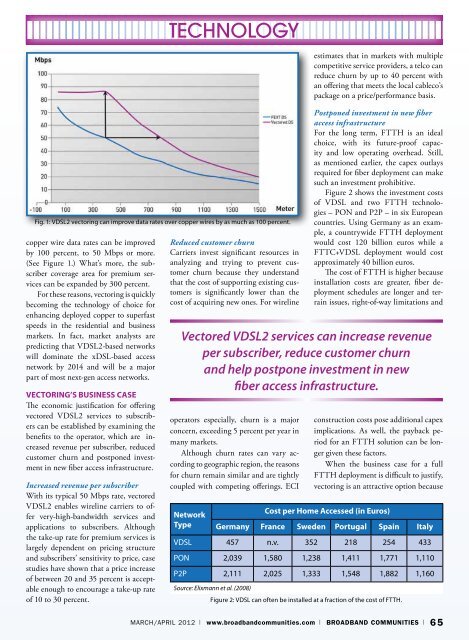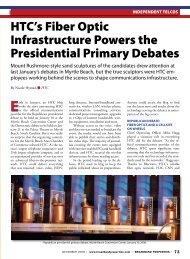March/April - Broadband Communities Magazine
March/April - Broadband Communities Magazine
March/April - Broadband Communities Magazine
You also want an ePaper? Increase the reach of your titles
YUMPU automatically turns print PDFs into web optimized ePapers that Google loves.
TeCHnology<br />
Fig. 1: VDSL2 vectoring can improve data rates over copper wires by as much as 100 percent.<br />
copper wire data rates can be improved<br />
by 100 percent, to 50 Mbps or more.<br />
(See Figure 1.) What’s more, the subscriber<br />
coverage area for premium services<br />
can be expanded by 300 percent.<br />
For these reasons, vectoring is quickly<br />
becoming the technology of choice for<br />
enhancing deployed copper to superfast<br />
speeds in the residential and business<br />
markets. In fact, market analysts are<br />
predicting that VDSL2-based networks<br />
will dominate the xDSL-based access<br />
network by 2014 and will be a major<br />
part of most next-gen access networks.<br />
VeCTorING’s BUsINess Case<br />
The economic justification for offering<br />
vectored VDSL2 services to subscribers<br />
can be established by examining the<br />
benefits to the operator, which are increased<br />
revenue per subscriber, reduced<br />
customer churn and postponed investment<br />
in new fiber access infrastructure.<br />
Increased revenue per subscriber<br />
With its typical 50 Mbps rate, vectored<br />
VDSL2 enables wireline carriers to offer<br />
very-high-bandwidth services and<br />
applications to subscribers. Although<br />
the take-up rate for premium services is<br />
largely dependent on pricing structure<br />
and subscribers’ sensitivity to price, case<br />
studies have shown that a price increase<br />
of between 20 and 35 percent is acceptable<br />
enough to encourage a take-up rate<br />
of 10 to 30 percent.<br />
Reduced customer churn<br />
Carriers invest significant resources in<br />
analyzing and trying to prevent customer<br />
churn because they understand<br />
that the cost of supporting existing customers<br />
is significantly lower than the<br />
cost of acquiring new ones. For wireline<br />
Vectored VDSL2 services can increase revenue<br />
per subscriber, reduce customer churn<br />
and help postpone investment in new<br />
fiber access infrastructure.<br />
operators especially, churn is a major<br />
concern, exceeding 5 percent per year in<br />
many markets.<br />
Although churn rates can vary according<br />
to geographic region, the reasons<br />
for churn remain similar and are tightly<br />
coupled with competing offerings. ECI<br />
Network<br />
Type<br />
estimates that in markets with multiple<br />
competitive service providers, a telco can<br />
reduce churn by up to 40 percent with<br />
an offering that meets the local cableco’s<br />
package on a price/performance basis.<br />
Postponed investment in new fiber<br />
access infrastructure<br />
For the long term, FTTH is an ideal<br />
choice, with its future-proof capacity<br />
and low operating overhead. Still,<br />
as mentioned earlier, the capex outlays<br />
required for fiber deployment can make<br />
such an investment prohibitive.<br />
Figure 2 shows the investment costs<br />
of VDSL and two FTTH technologies<br />
– PON and P2P – in six European<br />
countries. Using Germany as an example,<br />
a countrywide FTTH deployment<br />
would cost 120 billion euros while a<br />
FTTC+VDSL deployment would cost<br />
approximately 40 billion euros.<br />
The cost of FTTH is higher because<br />
installation costs are greater, fiber deployment<br />
schedules are longer and terrain<br />
issues, right-of-way limitations and<br />
construction costs pose additional capex<br />
implications. As well, the payback period<br />
for an FTTH solution can be longer<br />
given these factors.<br />
When the business case for a full<br />
FTTH deployment is difficult to justify,<br />
vectoring is an attractive option because<br />
Cost per Home accessed (in euros)<br />
Germany France sweden portugal spain Italy<br />
VDSL 457 n.v. 352 218 254 433<br />
PON 2,039 1,580 1,238 1,411 1,771 1,110<br />
P2P 2,111 2,025 1,333 1,548 1,882 1,160<br />
Source: Elixmann et al. (2008)<br />
Figure 2: VDSL can often be installed at a fraction of the cost of FTTH.<br />
<strong>March</strong>/april 2012 | www.broadbandcommunities.com | BROADBAND COMMUNITIES | 65



